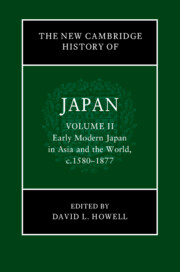Book contents
- The New Cambridge History of Japan
- The New Cambridge History of Japan
- The New Cambridge History of Japan
- Copyright page
- Contents
- Figures
- Maps
- Tables
- Contributors to Volume II
- Preface
- Frontispiece
- Introduction
- Part I The Character of the Early Modern State
- 1 The End of Civil War and the Formation of the Early Modern State in Japan
- 2 Politics and Political Thought in the Mature Early Modern State in Japan, 1650–1830
- 3 Regional Authority during the Tokugawa Period
- 4 Tokugawa Philosophy
- 5 Foreign Relations and Coastal Defense under the Mature Tokugawa Regime
- 6 The Meiji Restoration
- PART II Economy, Environment, and Technology
- Part III Social Practices and Cultures of Early Modern Japan
- Index
- References
1 - The End of Civil War and the Formation of the Early Modern State in Japan
from Part I - The Character of the Early Modern State
Published online by Cambridge University Press: 15 January 2024
- The New Cambridge History of Japan
- The New Cambridge History of Japan
- The New Cambridge History of Japan
- Copyright page
- Contents
- Figures
- Maps
- Tables
- Contributors to Volume II
- Preface
- Frontispiece
- Introduction
- Part I The Character of the Early Modern State
- 1 The End of Civil War and the Formation of the Early Modern State in Japan
- 2 Politics and Political Thought in the Mature Early Modern State in Japan, 1650–1830
- 3 Regional Authority during the Tokugawa Period
- 4 Tokugawa Philosophy
- 5 Foreign Relations and Coastal Defense under the Mature Tokugawa Regime
- 6 The Meiji Restoration
- PART II Economy, Environment, and Technology
- Part III Social Practices and Cultures of Early Modern Japan
- Index
- References
Summary
Japan between 1573 and 1651 underwent massive political and social transformation. The warlord Oda Nobunaga began the process of reunifying the archipelago after nearly a century of civil war, a process that was completed by his junior ally Toyotomi Hideyoshi. More conflict, both domestic and international, led to a third warlord, Tokugawa Ieyasu, positioning himself and his family as the new dynasty of military leaders who ruled a thoroughly pacified Japan beginning in 1603. His son, the second shogun Tokugawa Hidetada, and grandson, the third shogun Tokugawa Iemitsu, successively overcame diverse barriers to Tokugawa hegemony and incrementally established the early modern system that is often anachronistically assumed to have begun with Ieyasu. Their emphasis on pageantry, political immobility, strict control of borders, persecution of independent religion, and the constant threat of violence defined Tokugawa rule and allowed a fragile peace to persist until the mid-nineteenth century.
Keywords
- Type
- Chapter
- Information
- The New Cambridge History of Japan , pp. 15 - 57Publisher: Cambridge University PressPrint publication year: 2023



